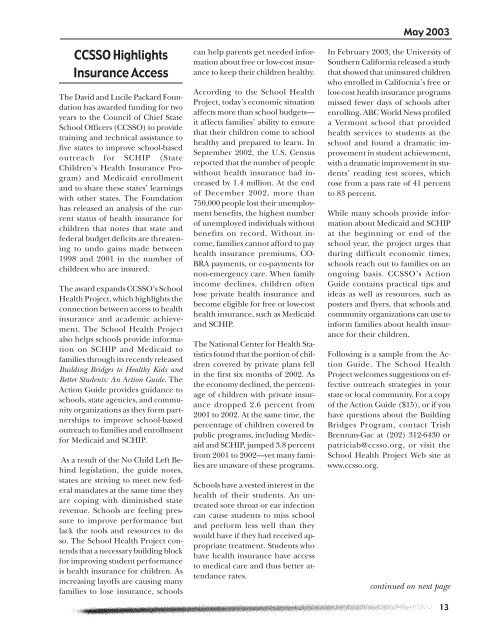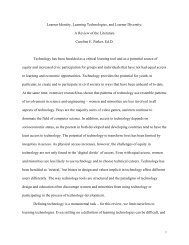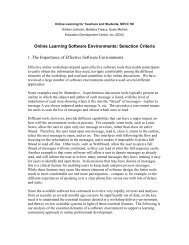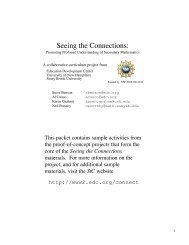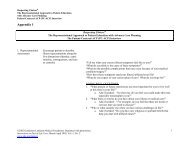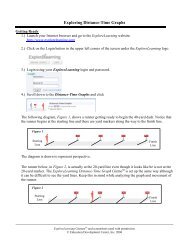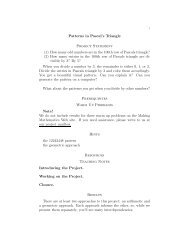School Health Program News - Education Development Center
School Health Program News - Education Development Center
School Health Program News - Education Development Center
You also want an ePaper? Increase the reach of your titles
YUMPU automatically turns print PDFs into web optimized ePapers that Google loves.
CCSSO HighlightsInsurance AccessThe David and Lucile Packard Foundationhas awarded funding for twoyears to the Council of Chief State<strong>School</strong> Officers (CCSSO) to providetraining and technical assistance tofive states to improve school-basedoutreach for SCHIP (StateChildren’s <strong>Health</strong> Insurance <strong>Program</strong>)and Medicaid enrollmentand to share these states’ learningswith other states. The Foundationhas released an analysis of the currentstatus of health insurance forchildren that notes that state andfederal budget deficits are threateningto undo gains made between1998 and 2001 in the number ofchildren who are insured.The award expands CCSSO’s <strong>School</strong><strong>Health</strong> Project, which highlights theconnection between access to healthinsurance and academic achievement.The <strong>School</strong> <strong>Health</strong> Projectalso helps schools provide informationon SCHIP and Medicaid tofamilies through its recently releasedBuilding Bridges to <strong>Health</strong>y Kids andBetter Students: An Action Guide. TheAction Guide provides guidance toschools, state agencies, and communityorganizations as they form partnershipsto improve school-basedoutreach to families and enrollmentfor Medicaid and SCHIP.As a result of the No Child Left Behindlegislation, the guide notes,states are striving to meet new federalmandates at the same time theyare coping with diminished staterevenue. <strong>School</strong>s are feeling pressureto improve performance butlack the tools and resources to doso. The <strong>School</strong> <strong>Health</strong> Project contendsthat a necessary building blockfor improving student performanceis health insurance for children. Asincreasing layoffs are causing manyfamilies to lose insurance, schoolscan help parents get needed informationabout free or low-cost insuranceto keep their children healthy.According to the <strong>School</strong> <strong>Health</strong>Project, today’s economic situationaffects more than school budgets—it affects families’ ability to ensurethat their children come to schoolhealthy and prepared to learn. InSeptember 2002, the U.S. Censusreported that the number of peoplewithout health insurance had increasedby 1.4 million. At the endof December 2002, more than750,000 people lost their unemploymentbenefits, the highest numberof unemployed individuals withoutbenefits on record. Without income,families cannot afford to payhealth insurance premiums, CO-BRA payments, or co-payments fornon-emergency care. When familyincome declines, children oftenlose private health insurance andbecome eligible for free or low-costhealth insurance, such as Medicaidand SCHIP.The National <strong>Center</strong> for <strong>Health</strong> Statisticsfound that the portion of childrencovered by private plans fellin the first six months of 2002. Asthe economy declined, the percentageof children with private insurancedropped 2.6 percent from2001 to 2002. At the same time, thepercentage of children covered bypublic programs, including Medicaidand SCHIP, jumped 3.8 percentfrom 2001 to 2002—yet many familiesare unaware of these programs.<strong>School</strong>s have a vested interest in thehealth of their students. An untreatedsore throat or ear infectioncan cause students to miss schooland perform less well than theywould have if they had received appropriatetreatment. Students whohave health insurance have accessto medical care and thus better attendancerates.May 2003In February 2003, the University ofSouthern California released a studythat showed that uninsured childrenwho enrolled in California’s free orlow-cost health insurance programsmissed fewer days of schools afterenrolling. ABC World <strong>News</strong> profileda Vermont school that providedhealth services to students at theschool and found a dramatic improvementin student achievement,with a dramatic improvement in students’reading test scores, whichrose from a pass rate of 41 percentto 83 percent.While many schools provide informationabout Medicaid and SCHIPat the beginning or end of theschool year, the project urges thatduring difficult economic times,schools reach out to families on anongoing basis. CCSSO’s ActionGuide contains practical tips andideas as well as resources, such asposters and flyers, that schools andcommunity organizations can use toinform families about health insurancefor their children.Following is a sample from the ActionGuide. The <strong>School</strong> <strong>Health</strong>Project welcomes suggestions on effectiveoutreach strategies in yourstate or local community. For a copyof the Action Guide ($15), or if youhave questions about the BuildingBridges <strong>Program</strong>, contact TrishBrennan-Gac at (202) 312-6430 orpatriciab@ccsso.org, or visit the<strong>School</strong> <strong>Health</strong> Project Web site atwww.ccsso.org.continued on next page13


